
Exposure dating project pages
| ESS 461 home |
| Information |
| Lecture notes |
| Labs |
| Research project |
| Term papers |
| Reading |
| Web resources |
| Footnotes |
| FAQ |
Rock crushing
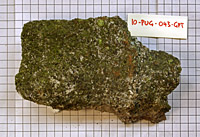 |
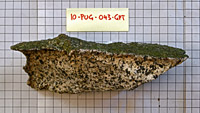 |
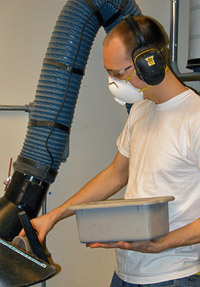 |
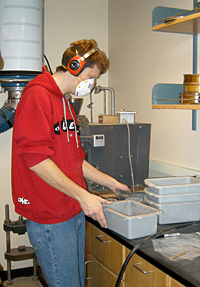 |
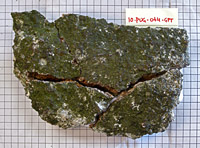 |
 |
Step 1, sketch and photograph the samples. Saturday 12 April, 11 am ...
First we need to record the size and condition of the samples. Most importantly we need to measure sample thickness. Cosmic rays get stopped (attenuated) as they pass through rock, so production rates of cosmogenic isotopes decrease with depth. To determine exposure ages we'll need to calculate the production rate of Be-10, allowing for the different thickness of each sample.
We also want to keep a record of the surface condition of the samples and their degree of weathering. All samples from this area have rough, granular surfaces due to breakdown of feldspar and mica. This suggests that they have eroded a few centimeters since exposure began. Erosion uncovers rock that was formerly shielded from cosmic radiation, so we will also have to correct for this effect when calculating their exposure ages.
Notice also that sample 043-GPT is a fairly mafic granodiorite. Close up you can see that it contains not only biotite but also hornblende and a trace of garnet. This will add a few steps to the mineral separation we use to purify quartz.
Step 2, rock crushing. Saturday 12 April, midday ...
First break the rock down to bite-size chunks. Feed these to the jaw crusher, which produces a coarse, gravelly grit. Take this and pass it through the disc mill, where it gets reduced to sand-sized grains smaller than a millimeter.
Finally, sieve the crushed rock into size fractions: < 250 micrometers, 250-500 micrometers, 500-850 micrometers, and > 850 micrometers. For these rocks we'll use about 150 grams of the 250-500 micrometer fraction for the quartz separation.
Quartz separation
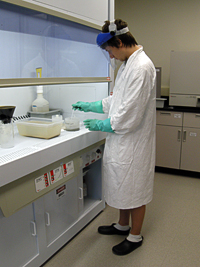 |
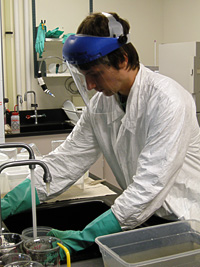 |
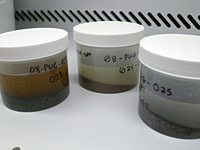 |
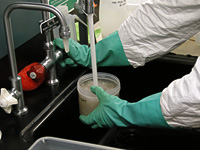 |
 |
 |
 |
 |
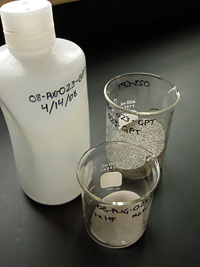 |
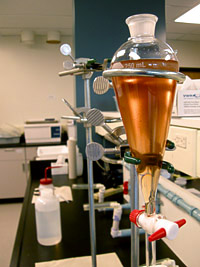 |
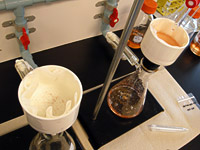 |
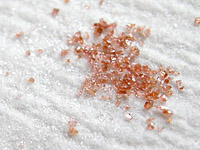 |
Step 1, rough quartz clean-up. Monday 14 April, 8 am ...
These rocks contain 10-15% quartz. First we need to free that from the feldspar, biotite and hornblende that make up the remaining 85-90% of the rock. We use a clever surfactant separation, which allows us to float off the contaminant minerals. The trick is to attach a hydrophobic surface coating of lauryl amine to the feldspar, biotite and hornblende grains. A trace of hydrofluoric acid (HF) keeps the quartz grain surfaces hydrophilic. When we froth the mixture with a stream of water from an aerated faucet, feldspar, biotite and hornblende cling to the bubbles and float to the surface and get caught in a foam that we stabilize with a trace of tea-tree or eucalyptus oil. Quartz is left behind on the bottom of the beaker.
Katherine, Nichole, Stephen and Zach put approximately 150 grams of each crushed sample through this process. Each produced 30-40 grams of rough quartz.
Step 2, quartz clean-up by selective dissolution. Monday 14 April, 10 am ...
The surfactant separation does a remarkable job, giving 95-98% pure quartz. For the Be separation, however, we need mineral separates with less than 100 ppm each of the elements Al, Fe and Ti, which tend to interfere with Be in the chemistry. The only way to achieve this level of purity (<0.1% of feldspar or mica) is selective dissolution of the contaminant minerals in dilute hydrofluoric acid (HF). HF dissolves most silicate minerals. Fortunately quartz dissolves more slowly than feldspar and the mafic silicates, so at the expense of a few grams of quartz, we can completely eliminate these other minerals.
We carry out this process in 1 liter plastic bottles, filled with approximately 1% HF (20 mL of concentrated (48%) HF to 950 mL of water). The bottles are kept at 70 ° C and agitated in an ultrasonic bath for 2-3 days.
Step 3, repeat the HF leaching. Thursday 17 April, 8 am ...
The dilute hydrofluoric acid does its work in a couple of days, after which the reaction rate slows down and little further dissolution takes place. Time to change the HF solution. The samples are looking very clean already, but we need to be sure we've reduced the feldspar concentration to < 0.1%. The second leaching also guarantees removal of all meteoric Be-10. HF is hazardous! Full protective gear is required whenever we're working with it. All HF waste must be neutralized in the large bucket of slurried limestone powder kept in the main fume hood.